Capital city home prices fell for the second consecutive month: Shane Oliver

EXPERT OBSERVER
Australian capital city average dwelling prices fell by 0.8% in June according to CoreLogic. This is their second decline in a row after a 0.5% fall in May and follows a 10.3% between June last year and April.
Capital city average prices have now fallen 1.2% since their peak in April.
Annual price growth has now slowed to 8.9% from 9.7% and its clear that the property cycle has now turned back down again. See the next chart.
Sydney dwelling prices fell by 0.8% and have now fallen by 1.2% from their April high.
Melbourne prices fell 1.1% and are down 2% from their March high.
Prices also fell in Brisbane (-0.4%), Adelaide (-0.2%) and Perth (-1.1%) but rose in Hobart (by 0.3%), Canberra (by 0.3%) and Darwin (by 0.1%).
Regional dwelling prices only fell 0.2% in June and are likely to hold up better reflecting lower levels of indebtedness and hence less vulnerability to the financial stresses caused by the economic downturn.
Source: CoreLogic, AMP Capital
The pace of home price growth has slowed from a peak of 23.8% annualised in November (or 2% month on month) to now a contraction at a -9.7% annualised pace in June (or -0.8% month on month).
The rebound in property prices from around mid-last year ended in April and the hit to the economy from the coronavirus shutdown and associated uncertainty is now driving property prices down. Were it not for JobKeeper, the increase in JobSeeker, the bank payment holiday and other support measures protecting heavily indebted households and property investors, prices would be falling more rapidly in response to forced sales.
Auction listings and clearance rates are up from their shutdown lows but they are still remain soft. See the next two charts.
Source: Domain, AMP Capital
Outlook
Further falls in home prices are likely. High and still rising unemployment (with “true” unemployment absent government support measures likely to be already around 14%), the collapse in immigration which has reduced underlying dwelling demand by around 80,000 dwellings a year and the depressed rental market will likely combine to drive weak housing demand and increased forced sales. JobKeeper, increased JobSeeker, bank payment holidays and other support measures have so far helped head off a sharp collapse in prices but the market has still weakened anyway and we expect further falls in prices particularly once support measures start to be phased down (albeit they are likely to be tapered down to avoid a “fiscal cliff” after September).
Our base case remains for national average prices to fall around 5-10% into next year, of which they have already fallen by 1.2%. Sydney & Melbourne are likely to see 10% falls as they are more exposed to immigration and have higher debt levels, with Melbourne facing the risk of a slightly higher fall due to its extended/partial lockdown whereas Adelaide, Brisbane, Perth & Hobart are only likely to see falls around 5% and Canberra prices are likely to be flat. This assumes that the recent acceleration in new coronavirus cases in Victoria is controlled by targeted regional lockdowns and travel restrictions and a renewed emphasis on social distancing rather than a return to a generalised lockdown across Australia.
However, if the resurgence in coronavirus cases in Victoria morphs into a broader “second wave” of cases across Australia necessitating a renewed economy wide lockdown and a renewed downturn in the economy then the likelihood of a 20% plus decline in prices will escalate. A premature wind back of government support measures would also add to the risk of a sharper fall in property prices than in our base case.
Shane Oliver | Head of Investment Strategy and Chief Economist | AMP Capital